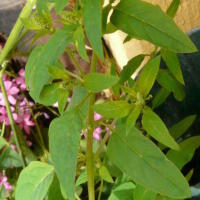Many-seeded goosefoot
Chenopodium polyspermum
Introduction:
Chenopodium polyspermum, commonly known as Many-seeded Goosefoot or Fat-hen, is an annual flowering plant belonging to the Amaranthaceae family. Native to Eurasia, this plant has become widespread and naturalized in many parts of the world. It is often found in disturbed areas, cultivated fields, and along roadsides.
Identification:
Appearance: Many-seeded Goosefoot is a herbaceous plant that can reach heights of 30 to 150 cm. The leaves are alternate, usually green, and vary in shape from lanceolate to rhombic. The flowers are small and inconspicuous, arranged in dense clusters.
Distinctive Features:
- Growth Form: Herbaceous annual, reaching heights of 30 to 150 cm.
- Leaves: Alternate, green, variable in shape from lanceolate to rhombic.
- Flowers: Small and inconspicuous, arranged in dense clusters.
Habitat and Distribution:
Many-seeded Goosefoot thrives in disturbed habitats, including agricultural fields, gardens, and waste areas. It is adaptable to a range of soil types and is commonly found in temperate regions. The plant has naturalized in various parts of North America, Europe, and other continents.
Ecological Role:
-
Pioneer Species: Many-seeded Goosefoot is often considered a pioneer species, colonizing disturbed or recently cultivated areas.
-
Food Source: The seeds of Chenopodium polyspermum are edible and have been historically used as a food source.
Cultural Uses:
Historically, Many-seeded Goosefoot has been used as a leafy vegetable in some cultures. The young leaves are edible and can be cooked or eaten raw. However, caution should be exercised, as certain varieties of Chenopodium contain oxalates, which can be toxic in large quantities.
Management Strategies:
-
Cultural Practices: Many-seeded Goosefoot is often managed through cultural practices that promote the growth of desirable vegetation.
-
Crop Rotation: In agricultural settings, implementing crop rotation practices can help reduce the prevalence of Many-seeded Goosefoot.
-
Herbicides: Selective herbicides targeting broadleaf weeds can be used for control, especially in cultivated areas.
Caution: As with any plant used for consumption, it is crucial to positively identify the species and follow proper preparation methods. Some varieties of Chenopodium contain oxalates, which, if consumed in excess, can be harmful.










